OBJECTIVES
The aim of the thesis is to create a virtual learning environment (VLE) with geographic content and perform its user assessment using eye-tracking. To achieve this, the thesis outlines two goals which are defined and explained as follows.
The primary objective of this thesis is to create a VLE that incorporates geographic content. This includes a comprehensive literature review to examine the current utilization of immersive virtual environments in geographic education. Building upon the literature review, the thesis will focus on selecting specific topic to be visualized within the VLE. The selection process will prioritize the potential use of Copernicus data, taking into consideration the current state of the art and emerging trends in geographic education. This approach ensures that the chosen topics align with contemporary educational needs and leverage the wealth of geographic information available through Copernicus. Using the selected topic, the thesis will involve designing and developing a VLE that provides an immersive and interactive platform for geographic education. This will entail creating realistic three-dimensional (3D) visualizations, integrating accurate geographic data, and implementing interactive features to enhance the learning experience. The thesis outputs will be the final version of the VLE, and the description of how to create virtual geographic learning environment.
The second goal is to perform user assessment of created VLE using eye-tracking. The thesis will employ eye-tracking technology to reveal general insights about VLE. The thesis will analyze the collected eye-tracking data to understand the spatial experience of users in virtual geographic learning environment. This analysis will involve examining gaze patterns, initial daze dispersion and other relevant metrics to assess users' attention to specific geographic content. Based on the findings from the eye-tracking analysis and subjective evaluation methods, the thesis will determine the effectiveness of the design and identify any usability issues or challenges that may impact the learning experience. This evaluation will inform future enhancements and refinements to optimize the virtual learning environment's educational impact.



